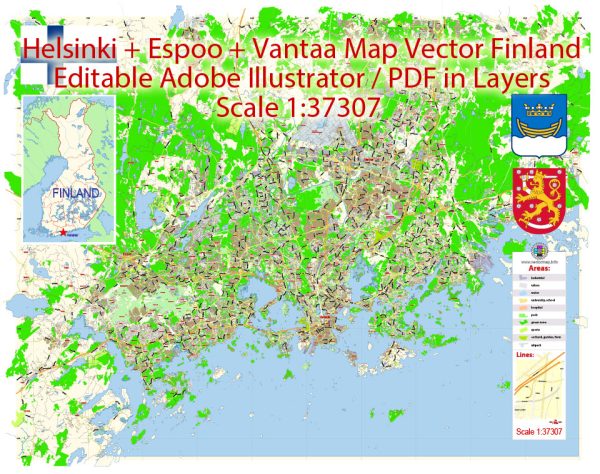Helsinki, Espoo, and Vantaa are three major cities in the Greater Helsinki area, forming the core of the Finnish capital region. Each city has its own unique history of urban development, but they are closely interconnected, and their stories reflect broader trends in Finnish and European urbanization.
Helsinki:
- Foundation: Helsinki was founded in 1550 by King Gustav I of Sweden as a trading town to compete with Tallinn. The location was chosen for its proximity to the sea and its potential as a harbor.
- Capital City: In 1812, Helsinki became the capital of the newly established Grand Duchy of Finland, a part of the Russian Empire. This decision by Tsar Alexander I led to increased attention and investment in the city.
- Architectural Influences: The city experienced rapid growth in the 19th century, and many of its iconic neoclassical buildings date from this period. Architect Carl Ludvig Engel played a significant role in shaping the cityscape.
- Independence and Modernization: Finland gained independence from Russia in 1917. The interwar period and post-World War II era saw significant industrialization and urbanization, with the city expanding and modernizing its infrastructure.
- Design Capital: Helsinki has gained a reputation as a design and cultural hub. The city’s commitment to urban planning and design is evident in its well-designed public spaces, modern architecture, and commitment to sustainability.
Espoo:
- Historical Roots: Espoo has a long history, with traces of human settlement dating back to the Iron Age. However, it remained predominantly rural until the mid-20th century.
- Suburban Development: Espoo underwent significant transformation in the 20th century, evolving from a collection of rural communities into a major suburban area. The development of modern infrastructure, including roads and public transportation, played a crucial role.
- Science and Technology Hub: In recent decades, Espoo has become known as a center for science and technology. It is home to the Otaniemi campus of Aalto University, as well as numerous high-tech companies. This has influenced the city’s modern identity.
Vantaa:
- Historical Background: Vantaa has ancient origins, with archaeological evidence suggesting human presence in the area as far back as the Stone Age.
- Agriculture and Industry: Like Espoo, Vantaa remained primarily rural until the mid-20th century. Industrialization and the expansion of transportation infrastructure, such as the Helsinki-Vantaa Airport, contributed to urbanization.
- Airport Growth: The opening of the Helsinki-Vantaa Airport in 1952 had a significant impact on Vantaa’s development. It became a key transportation hub and contributed to the growth of business and industry in the region.
- Cultural and Recreational Spaces: Vantaa has also invested in cultural and recreational facilities, enhancing the quality of life for its residents. The city has museums, parks, and other amenities that contribute to its appeal.
Overall, the history of urban development in Helsinki, Espoo, and Vantaa reflects a transition from historical roots to modern, dynamic cities. The evolution from trading posts and rural areas to vibrant urban centers underscores Finland’s broader journey through social, economic, and cultural changes.


 Author: Kirill Shrayber, Ph.D.
Author: Kirill Shrayber, Ph.D.